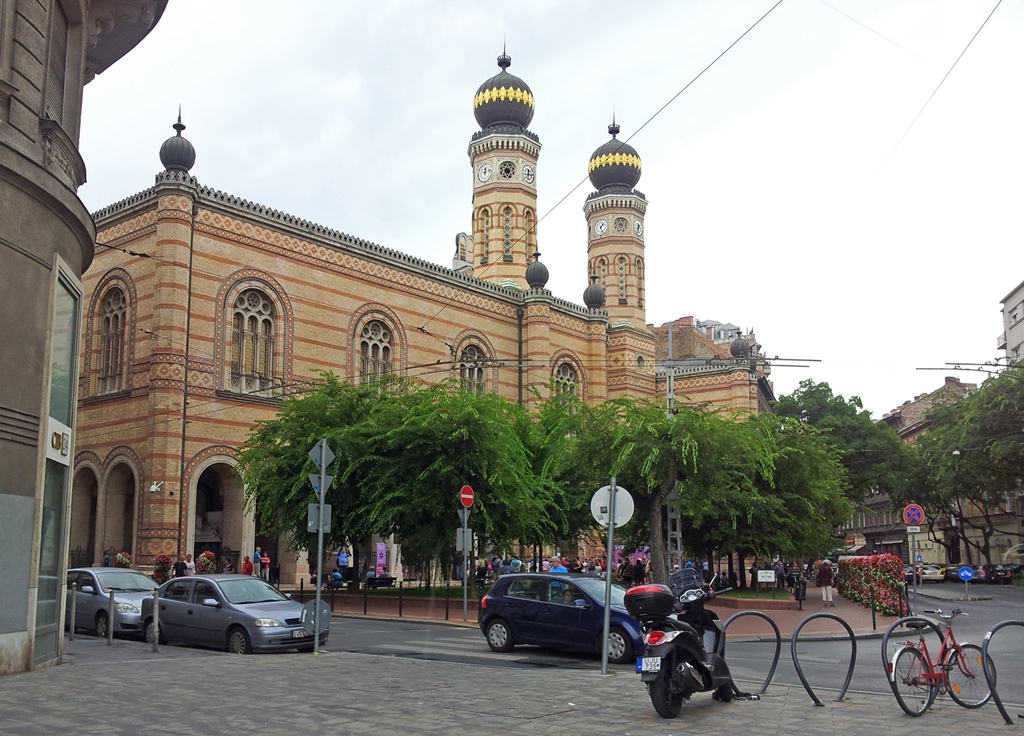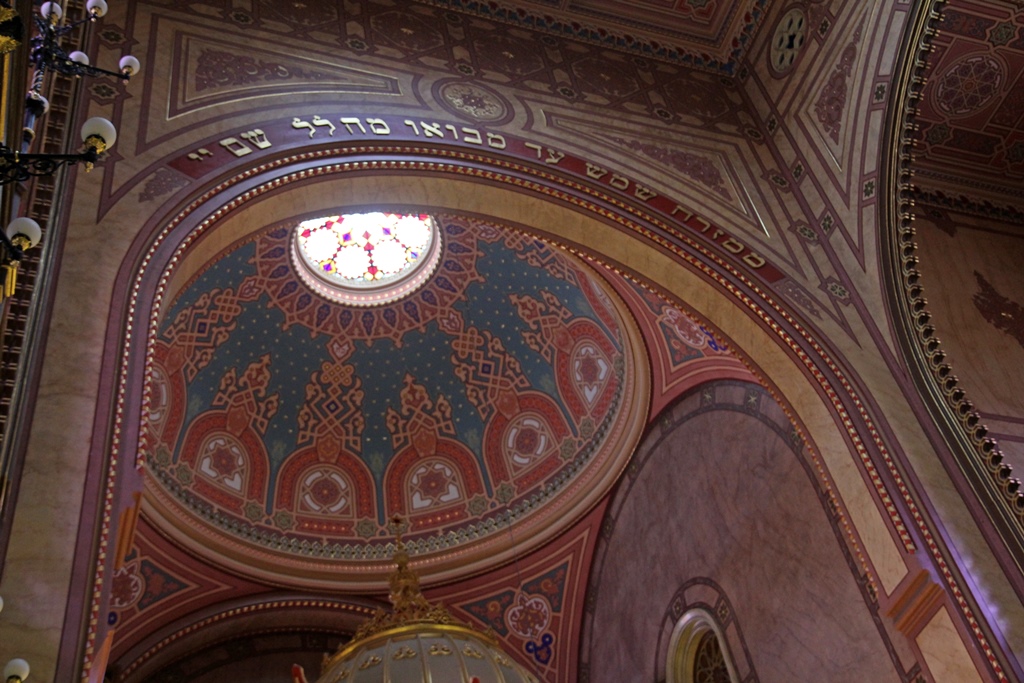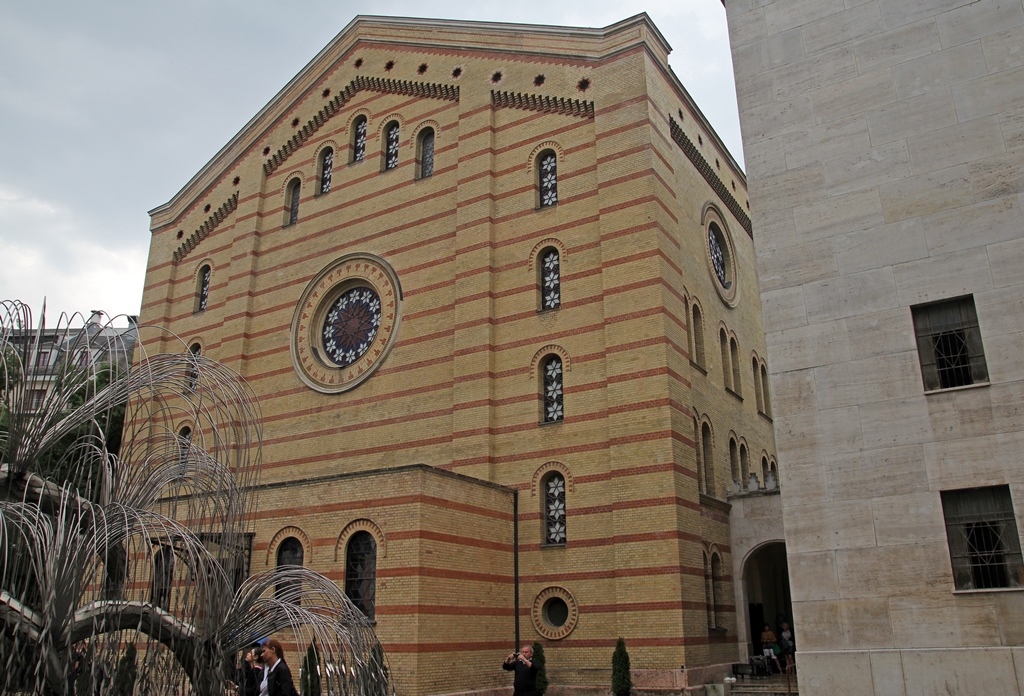Note: A YouTube companion video for this page can be found
here.
The Great Synagogue of Budapest,
also known as the Dohány Street Synagogue (after the street that passes by its façade), is
billed as the largest synagogue in Europe, and the second-largest in the world (after the
Temple Emanu-El in New York City). It was highly recommended in our guide book for its
religious significance, its beauty and its history. We found it to be within walking
distance of our hotel, so after breakfast, despite the weather being somewhat threatening,
we headed over on foot.
Great Synagogue
The synagogue was built between 1854 and 1859, in what's known as the Moorish Revival
style. Dohány Street, on which it was built, was considered to be the border of Budapest's
Jewish Quarter at the time. Many Jews still live on the street, which is also home to some
additional architecture of interest. But we didn't spend much time looking at the local
buildings, as rain was beginning to fall. We hastily paid our admission fee and entered
the building.

Building with "Four Seasons" Mosaic
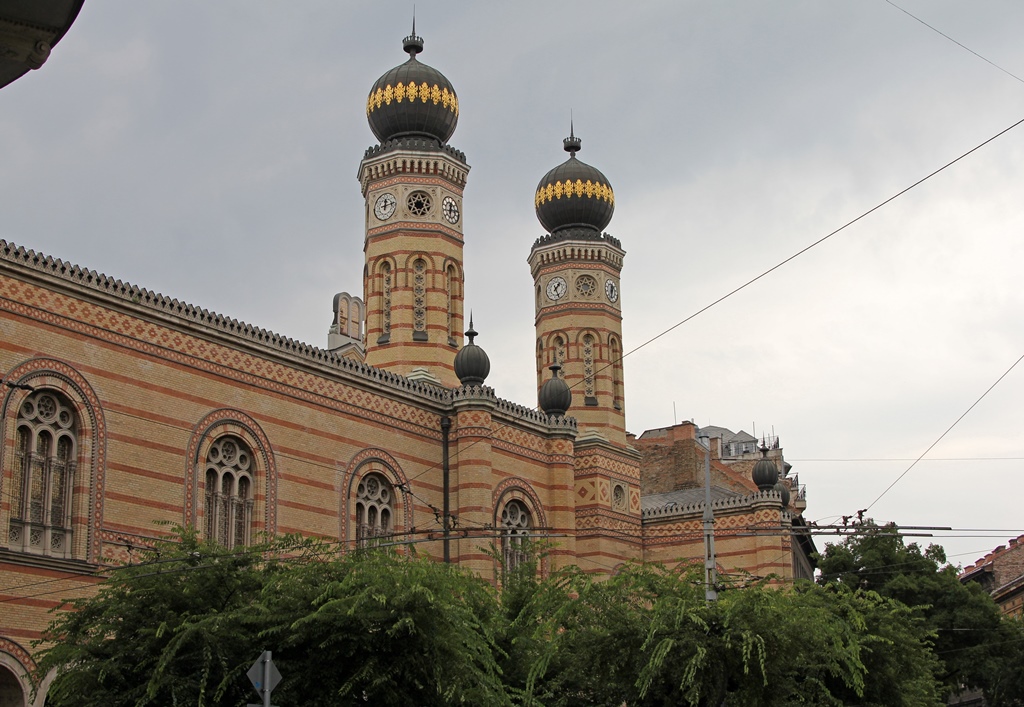
Great Synagogue
The synagogue grounds are also home to a number of other attractions, including the
Hungarian Jewish Museum, a cemetery,
a building called the Heroes' Temple, and a Memorial Park. We didn't visit the
museum (it was very crowded) or the temple (it didn't seem to be open), but we did
visit the other places, beginning with the synagogue itself.
We'd never been inside a working synagogue before, and weren't sure quite what to
expect. Our experiences with places of worship had almost entirely been with
Christian churches and cathedrals, and as it turned out the synagogue had both
similarities and differences. This particular synagogue was a Neolog (as opposed
to an Orthodox) synagogue, and some of its features apparently differ from those
of an Orthodox synagogue.
We ran into the first difference from a cathedral immediately – while Christian
churches require that you remove any headwear you might be wearing, the synagogue
had the opposite requirement: headwear was mandatory for men, but apparently not
for women. The synagogue supplied white paper yarmulkes for those who needed them,
but they seemed OK with the baseball-style cap I was already wearing.
The inside of the synagogue was surprisingly churchlike. There was an altar at the
front, with many rows of pews facing it. There were pulpits on both sides, toward
the front, and there were stained-glass windows. The altar was flanked by organ
pipes, and there was even an ornate dome above it. There were two levels of
balconies along both the left and right sides of the synagogue, a feature not
unknown to large Christian churches. On the other hand, as would be expected,
there weren't any crosses or representations of Jesuses or Virgins or saints
anywhere. There were some stars of David, but not many, and they weren't
particularly prominent. The decorations most indicative of the building being a
synagogue were some Hebrew inscriptions. As promised in the guidebook, all of this
was gorgeous.
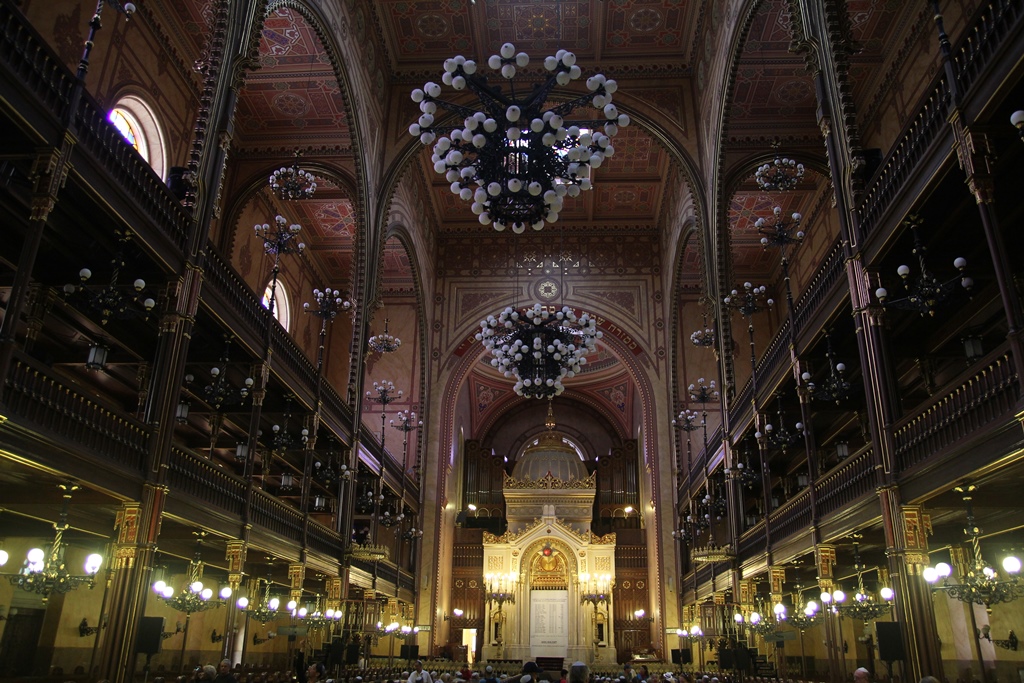
Inside the Synagogue

Chandelier
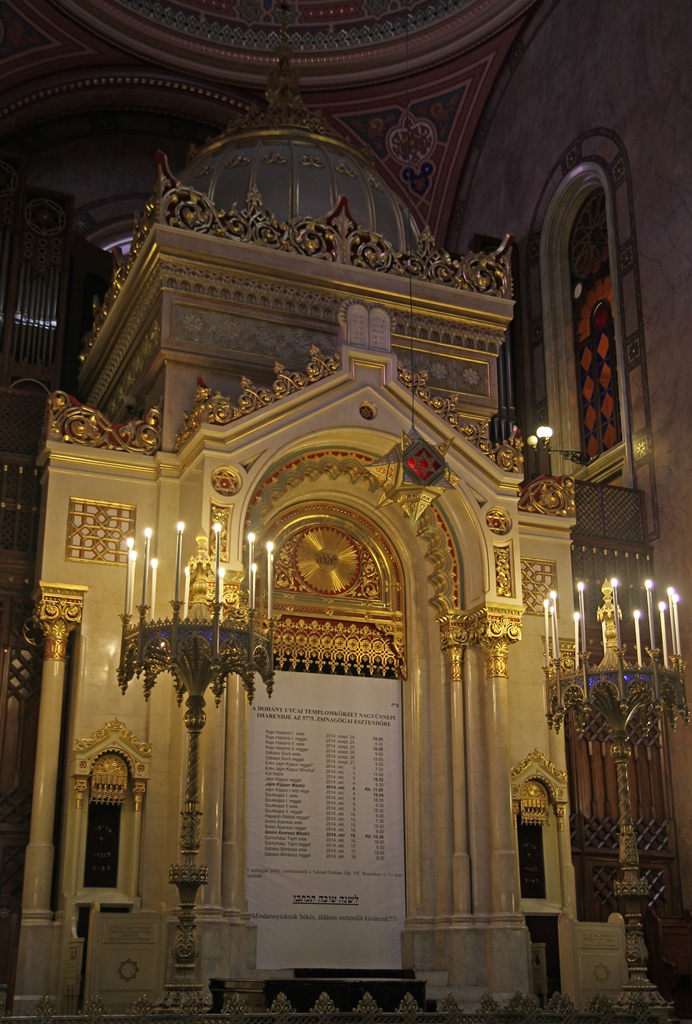
Altar (Ark)

Candelabra
Dome
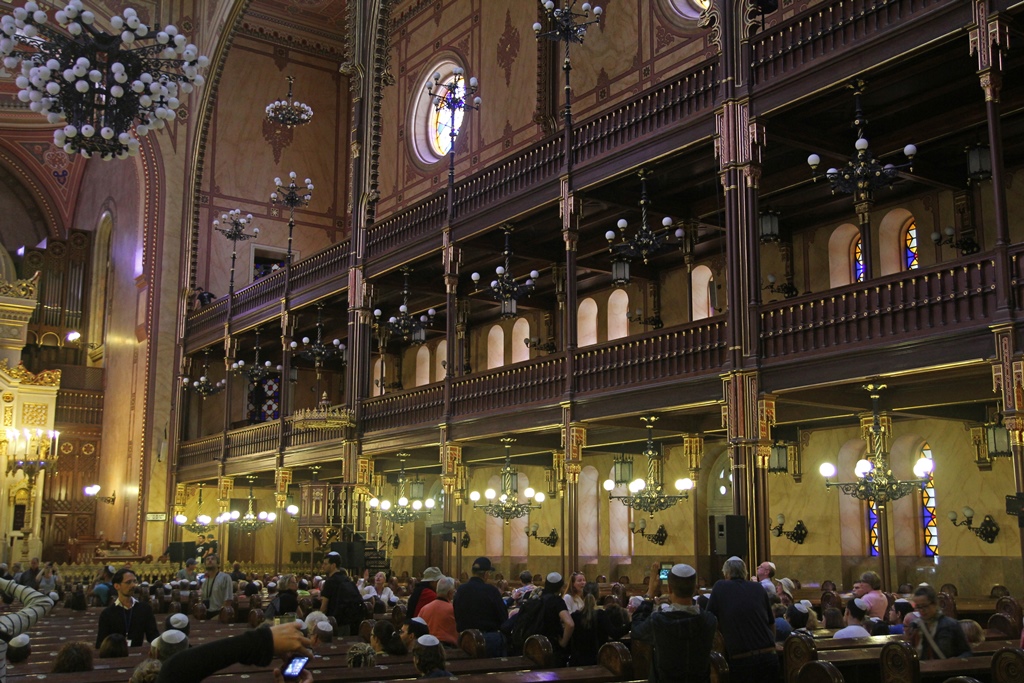
Balconies
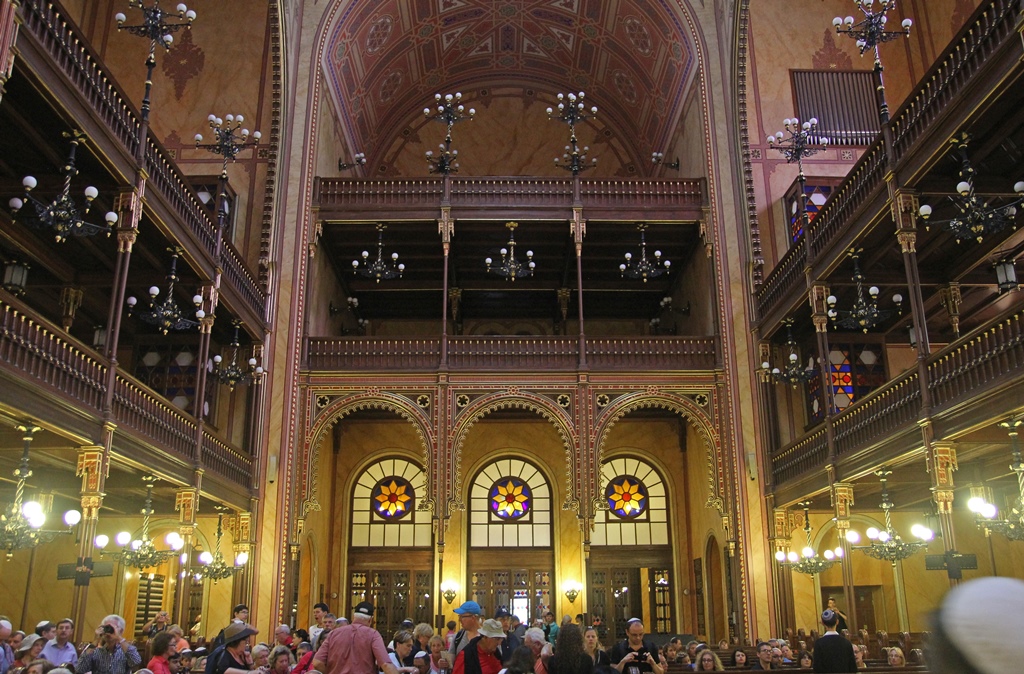
Back Portion Of Synagogue

Ceiling
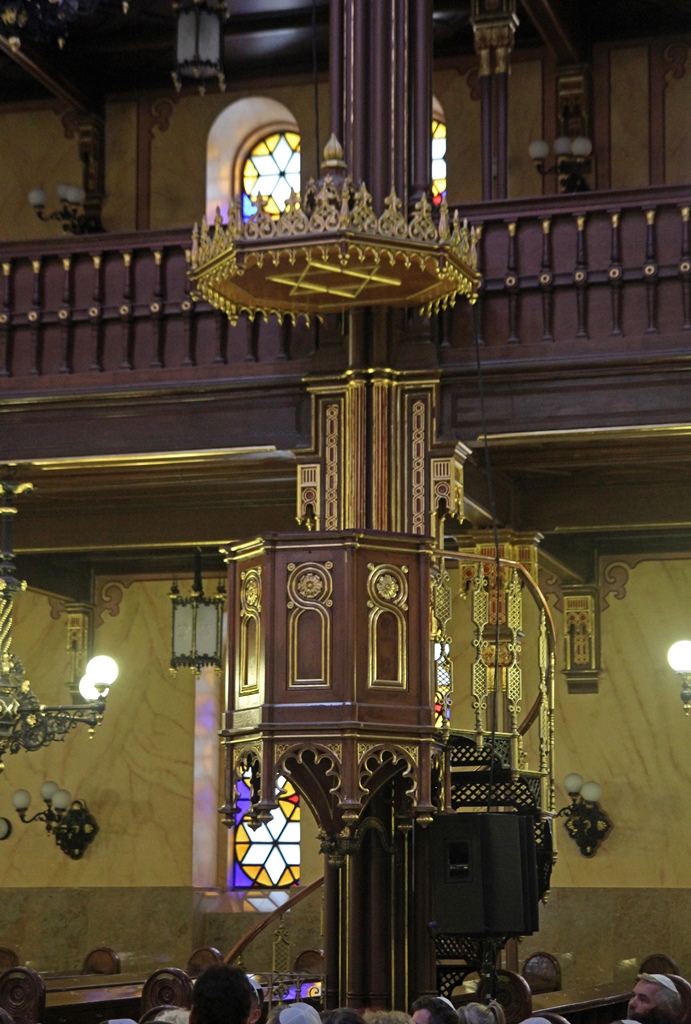
Pulpit
I'm not sure how typical this layout was for a synagogue (apparently there is a fair
amount of variability), but there were some differences from what one might expect in a
traditional Orthodox synagogue. In both types of synagogues, attention of the attendees
is focused on an area where someone (a rabbi, I would guess) would be speaking or reading
during a service. In the Great Synagogue, this area is at one end of the building, as it
would be in a typical Christian church, but in a traditional synagogue, this area might
instead be in the center of the building, which would be surrounded by seating (so everyone
can see and hear better, which would be difficult for someone at the opposite end of a
large building). In all synagogues there is a container called the ark, in which the
scrolls of the Torah are kept (the Torah consists of five books of the Old Testament – Genesis,
Exodus, Leviticus, Numbers and Deuteronomy), and the ark is almost always placed on a wall,
typically the wall facing Jerusalem. In a synagogue like the Great Synagogue, the ark is
usually located behind the speaker's platform. In the case of the Great Synagogue, more than
the usual number of scrolls are stored, as scrolls were collected here from some of the
Hungarian synagogues that were destroyed during the Holocaust.
During ceremonies in a synagogue, men and women are typically kept away from each other
(apparently men are distractible creatures). In some synagogues there is a curtain that
separates the men's section from the women's section, but in others, like the Great Synagogue,
the women are relegated to balconies.
Exiting the synagogue building took us to a courtyard surrounded on three sides by the
synagogue, the museum and the Heroes' Temple. The courtyard itself was roped off from
visitors, who could view it from an arcade along the side of the synagogue. The courtyard
appeared fairly ordinary, except for many stones engraved with names of people, mostly leaning
against the borders of planters. It was almost like a number of headstones had been prepared
and were awaiting delivery to a cemetery. But a little investigation revealed two important
facts. First, the courtyard was the cemetery. And second, the headstones, while
numerous, represented a small fraction of the headstones which could justifiably have been
placed there. An additional fact is at first somewhat puzzling – unlike the situation for
Christian churches, the placement of a cemetery adjacent to a synagogue is highly unusual, and
in fact there are rules explicitly forbidding this practice. To understand this exception,
one must know a few things about events which occurred during the fall and winter of 1944-45.

Cemetery
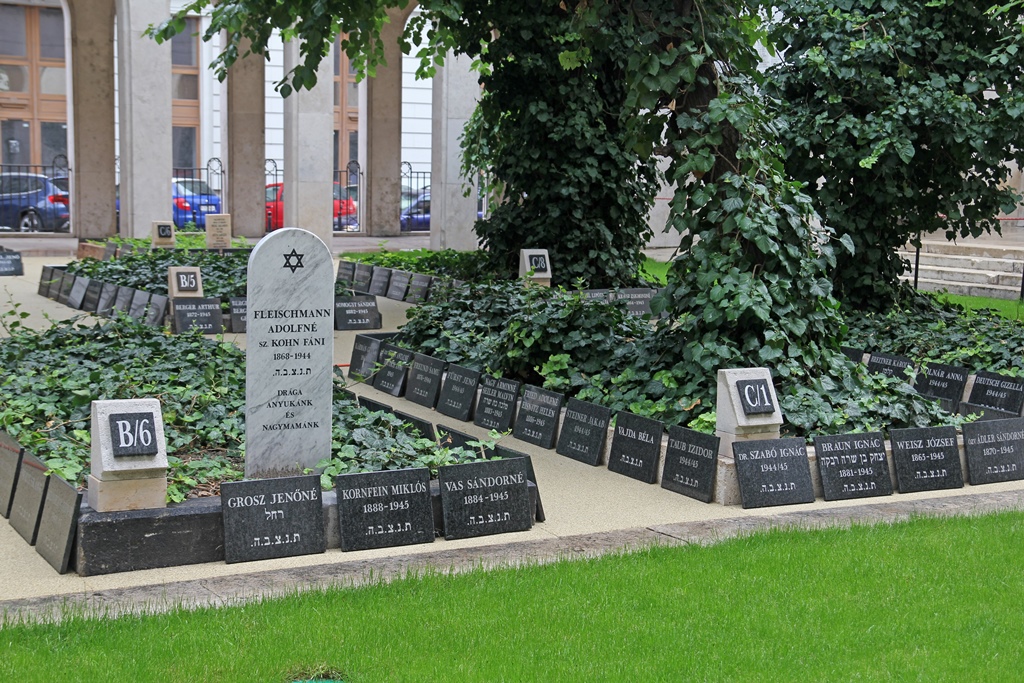
Cemetery
In late 1944, the Germans, with whom the Hungarians were allied, had a lot of things
other than Hungary on their mind, and with the Soviet Red Army approaching, the
Hungarian government had become unstable and vulnerable. On October 15 there was a
coup in which the government was taken over by a radically anti-Semitic group called
the Arrow Cross, or Nyilas. Tens of thousands of Hungarian Jews were exported
by this new government to the hospitality of the Germans, either through forced
marches to the Austrian border, or through direct deportation to places like the
Bergen-Belsen concentration camp in Germany. In Budapest, an area was set aside and
walled off as a Jewish ghetto, with 55,000 people crowded into it as of November.
Over time, others were forcibly moved to the ghetto, until the number swelled to
70,000 as of January 1945. The ghetto's occupants were not well taken care of by
their captors – shortages of food and medicine, and the harshness of the winter of
1944-45 contributed to the deaths of thousands. Also, the Nyilas dropped by
frequently to conduct raids and mass executions. Conditions made it impossible to
bury so many, and unburied corpses accumulated on the streets (and also in the
courtyard of the Dohány Street Synagogue). The Soviet Army liberated the ghetto on
January 18, to the obvious relief of the survivors, but found it necessary to
commence mass burials immediately. Their gruesome task was completed by mid-February,
with the victims being buried in three principal locations – two cemeteries in the
ghetto area, and the courtyard of the Dohány Street Synagogue. It's estimated that
more than 2,000 victims were buried in the courtyard. It's not known exactly who was
buried in each of the three locations, but over the years relatives have brought
headstones to the synagogue, and many of them have been placed in the courtyard. And
while there is a rule that cemeteries should not be placed next to synagogues, there
is a stricter rule that human remains, once buried, should not be moved.
Situated at the north end of the courtyard is the Heroes' Temple, a domed,
fortress-like building that was erected in 1931 as a memorial to Hungarian Jews who
gave their lives fighting for their country in World War I (as with World War II, on
the same side as the Germans). It was not open for visitors when we were there.

Temple of Heroes
One might think that Jews fighting and dying for Hungary would make them popular among
the Hungarian population. This turned out not to be the case, as evidenced by the
final point of interest on the synagogue grounds, the Raoul Wallenberg Holocaust Memorial
Park. Between the wars, as in much of Europe, Hungarian Jews had greater representation
in the ranks of many highly-paid professions (e.g. finance, law, and medicine, where the
practitioners were more than 50% Jewish) than they did in the general population (of
which they were about 5%). This led to resentment among the non-Jewish citizenry, which
spread to the government, which began passing anti-Jewish laws in 1938.
"Over-representation" of Jews in certain professions was addressed not by seeking out
any unfair barriers to others, or by incentivizing other groups to pursue those
professions more energetically, but by forcibly throwing many Jews out of their jobs.
In the ensuing months and years persecution of Jews increased, and in 1941 thousands of
foreign Jews (which included many Hungarian Jews who couldn’t pull their proof of
citizenship together) were deported. The deportees mostly ended up in places where
German forces could easily pick them up, and many thousands were either sent to
concentration camps or massacred outright, via Einsatzgruppen, or mobile killing
units. Persecution continued in Hungary, often at the hands of the Hungarian Army or
police forces, but the Hungarian government did draw one line they wouldn't go past:
they would not deport Hungarian Jews to the Nazi extermination camps (e.g. Auschwitz),
despite pressure from the Germans. But eventually the Germans lost patience, and in
March of 1944 they replaced the Hungarian government with one that was more
accommodating. Preparations proceeded apace, and by May trains were shipping 12,000
Jews to Auschwitz daily, with 90% exterminated on arrival. The Hungarian police force
was quite efficient, drawing the admiration of Adolf Eichmann, who was supervising the
operation. Eventually a combination of the Allies' Normandy invasion, international
(and papal) pressure and an attempt on Hitler's life caused the deportations to start
slowing down in July, and they finally stopped in August. But only after hundreds of
thousands of Hungarian Jews had fallen victim to the extermination machine. It is
estimated that about one-third of all those murdered at Auschwitz came from Hungary.
The Wallenberg Holocaust Memorial Park is not very big, and seems inadequate to address
such a horrific chapter of Hungarian history. But it's difficult to imagine a
commemoration that would seem sufficient. Looking around at the various memorials, we
were struck by the presence of pebbles throughout the park. Apparently each pebble
represents a prayer.

Nella and Stained Glass Panel
One monument, surrounded by a great mass of pebbles, is dedicated to Raoul Wallenberg,
after whom the park is named. Wallenberg was a special envoy to Hungary from Sweden who
is credited with saving the lives of tens of thousands of Hungarian Jews. He did this by
issuing "protective passports" to Jews which identified them as Swedish subjects awaiting
repatriation (Sweden was officially a neutral country during the war), making them immune
to deportation. This wasn't legal, but the passports looked official and he sometimes
added bribes for certain key officials. He arrived in Budapest in July of 1944, too late
to save many, but it's clear that he did everything he could think of to accomplish his
purpose. For instance, he would actually intercept trainloads of deportees before they departed,
handing the occupants passports through the windows and telling them to leave the
railroad cars and go to Swedish-flagged automobiles that were waiting for them. Guards
would yell at him to leave and shoot over his head, but he wouldn't quit until running
out of passports. He rented several buildings to house all of the new "Swedish citizens"
until they could be taken out of the country, saying the buildings were protected by
diplomatic immunity. Two days before the Soviet occupation of the city, Wallenberg
issued a note to the remaining German officials warning them of possible war crime
prosecution if they executed a plan they had to blow up the entire Jewish ghetto (with
70,000 people in it); this may have kept the plan from being carried out.
While the Wallenberg memorial looks something like a grave, Wallenberg isn't in it. On January
17, 1945, he was summoned to the Soviet general's headquarters, and he was never seen
again. It seems he was suspected by the Soviets of being a spy - there are sketchy
claims from the Russians about his death while in their captivity, and plausible
counter-claims that he was seen alive after this time. In 1989 some of his personal
belongings were returned to his family, the Soviets saying that they were found in a
storeroom. Wallenberg's ultimate fate seems to be a mystery that may never be solved. At
any rate, he has a well-earned memorial in Budapest. Also inscribed on the memorial are
several additional names belonging to others who similarly rescued condemned Hungarian Jews at
great personal risk.

Memorial to Raoul Wallenberg
The most conspicuous memorial in the park is a sculpture called the Tree of Life, which
looks like a metallic weeping willow. Its metal leaves all have names of Hungarian Holocaust
victims on them.

Bob with Tree of Life

"Leaves", Tree of Life
Having had our fill of the Holocaust for one day, we left the park, retraced our steps
through the cemetery and the synagogue, and ended up back on Dohány Street.
Back Entrance to Synagogue
We needed something to take our minds off the profound sadness to be found at a
Holocaust memorial, and decided that the Hungarian Parliament would be just the
thing. We found a Metro stop and a train that would take us there. Continue to
the next page to see how successful we were.

